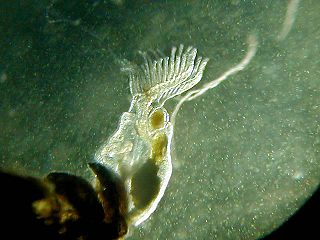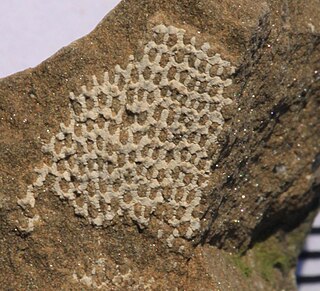
Bryozoa are a phylum of simple, aquatic invertebrate animals, nearly all living in sedentary colonies. Typically about 0.5 millimetres long, they have a special feeding structure called a lophophore, a "crown" of tentacles used for filter feeding. Most marine bryozoans live in tropical waters, but a few are found in oceanic trenches and polar waters. The bryozoans are classified as the marine bryozoans (Stenolaemata), freshwater bryozoans (Phylactolaemata), and mostly-marine bryozoans (Gymnolaemata), a few members of which prefer brackish water. 5,869 living species are known. One genus is solitary; all the rest are colonial.
Stenolaemata are a class of exclusively marine bryozoans. Stenolaemates originated and diversified in the Ordovician, and more than 600 species are still alive today. All extant (living) species are in the order Cyclostomatida, the third-largest order of living bryozoans.

Gymnolaemata are a class of Bryozoans. Gymnolaemata are sessile, mostly marine organisms and grow on the surfaces of rocks, kelp, and in some cases on animals, like fish. Zooids are cylindrical or flattened. The lophophore is protruded by action of muscles pulling on the frontal wall. This order includes the majority of living bryozoan species.

Cheilostomatida, also called Cheilostomata, is an order of Bryozoa in the class Gymnolaemata.

Lunaspis is an extinct genus of armor-plated petalichthyid placoderm fish that lived in shallow marine environments of the Early Devonian period, from approximately 409.1 to 402.5 million year ago. Fossils have been found in Germany, China and Australia. There are three different identified species of within the genus Lunaspis: L. broilii, L. heroldi, and L. prumiensis.

Phylactolaemata is a class of the phylum Bryozoa whose members live only in freshwater environments. Like all bryozoans, they filter feed by means of an extensible "crown" of ciliated tentacles called a lophophore. They live in colonies, each of which consists of clones of the founding member. Unlike those of some marine bryozoans, phylactolaemate colonies consist of only one type of zooid, the feeding forms known as autozooids. These are supported by an unmineralized "exoskeleton" made of gelatinous material or protein, secreted by the zooids. The class contains only one extant order, Plumatellida.
Fenestrata is an extinct order of bryozoan, dating from the Upper Arenig. Most fenestrate bryozoans formed net-like colonies that water currents flowed through, with autozooecial apertures only on the side of the colony facing into the current.This colony structure was vulnerable to predators, so some fenestrate bryozoans produced skeletal superstructures, likely to strengthen or protect the colony, and others had protective spines surrounding their autozooecial apertures.

Crepipora is an extinct genus of marine bryozoans belonging to the Ceramoporidae family. There are currently 18 collections from Belarus, Sweden, Canada, France and the United States. It was first assigned to Cystoporata by Sepkoski in 2002. The fossil range is from the Middle Ordovician to the Upper Ordovician.

Fenestellidae is a family of bryozoans belonging to the order Fenestrida. The skeleton of its colonies consists of stiff branches that are interconnected by narrower crossbars. The individuals of the colony inhabit one side of the branches in two parallel rows or two at the branch base and three or more rows further up. Zooids can be recognized as small rimmed pores, and in well-preserved specimens the apertures are closed by centrally perforated lids. The front of the branches carries small nodes in a row or zigzag line between the apertures. Branches split from time to time giving the colonies a fan-shape or, in the genus Archimedes, create an mesh in the shape of an Archimedes screw.
Clausotrypa is an extinct genus of prehistoric bryozoans in the family Nikiforovellidae. The species C. elegans is from a Wordian (Permian) marine horizon in the Sijiashan Formation of Northeast China.
Coenites is an extinct genus of prehistoric corals in the family Coenitidae. C dublinensis occurs in the Columbus Limestone, a mapped bedrock unit consisting primarily of fossiliferous limestone, and it occurs in Ohio, Pennsylvania, and Virginia in the United States, and in Ontario, Canada.
Coscinium is an extinct genus of prehistoric bryozoans in the family Hexagonellidae. The species C. elegans is from the Paleozoic rocks of the western states and territories.
Callocladia is an extinct genus of prehistoric bryozoans in the extinct family Crustoporidae.
Coscinopleura is an extinct genus of prehistoric bryozoans in the family Coscinopleuridae. Species are from the Paleocene of Sweden and New Jersey, United States. C. elegans and C. angusta are from the Senonian and Danian of Denmark.
Cystodictya is an extinct genus of prehistoric bryozoans in the extinct family Cystodictyonidae.
Crisiidae is a family of bryozoans in the suborder Articulina.
Crisia is a genus of bryozoans in the family Crisiidae. Some species are known from the fossil record.
Septopora is an extinct genus of bryozoan belonging to the order Fenestrida. It has been found in Pennsylvanian to Permian beds in North America, South America, Australia, and southwest and east Asia.

Feistiellaceae is a family of freshwater green algae in the order Charales.







